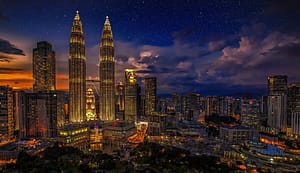When it was established on September 16, 1963, Malaysia comprised the territories of Malaya (now Peninsular Malaysia), the island of Singapore, and the colonies of Sarawak and Sabah in northern Borneo. In August 1965 Singapore seceded from the federation and became an independent republic.
Malaysia is a point of convergence of several major cultural traditions that stem from archipelagic Southeast Asia as well as from China, South Asia, the Middle East, and the West. Malay culture, the Orang Asli cultures of Peninsular Malaysia, and many of the cultures of East Malaysia are indigenous to the area. In the first one and a half millennia CE, indigenous Malay culture in the Malay Peninsula and in other parts of Southeast Asia was strongly marked by pre-Islamic Indian and early Islamic influences. Indian contact with the Malay Peninsula, which extended from about the 2nd or 3rd century to the late 14th century, exerted a profound influence on religion (through Hinduism and Buddhism), art, and literature. Islam, introduced to Malacca (now Melaka) in the 15th century, soon became the dominant religion of the Malays. Western cultural influences, especially since the 19th century, also have affected many aspects of Malay life, particularly in the realms of technology, law, social organization, and economics. Contemporary Malay culture is thus multifaceted, consisting of many strands—indigenous, early Hindu, early and modern Islamic, and, especially in the cities, Western—interwoven to yield a pattern that is distinct from other cultures yet recognizably Malay.
The early Chinese traders who settled in Malacca and on the island of Penang were partially assimilated (at least to the extent of adopting the Malay language). By contrast, the Chinese who emigrated in large numbers to the Malay Peninsula in the late 19th and early 20th centuries were both a more heterogeneous group and a largely transient population that tended to establish self-contained communities. Chinese cultural influence in this region, then, has been less pronounced.
The communities of Malaysia have been affected profoundly by British colonial rule and Western cultural influences, especially in education and institutional forms. The rural areas—particularly in eastern Peninsular Malaysia and in the interior of East Malaysia—have been least affected, while the cities have been the focus of the most-rapid cultural changes. However, extraordinary economic growth and development since the mid-20th century increasingly has allowed a cosmopolitan outlook, carried largely from the urban centres by an expanding middle class, to penetrate smaller towns and even newer rural settlements.

